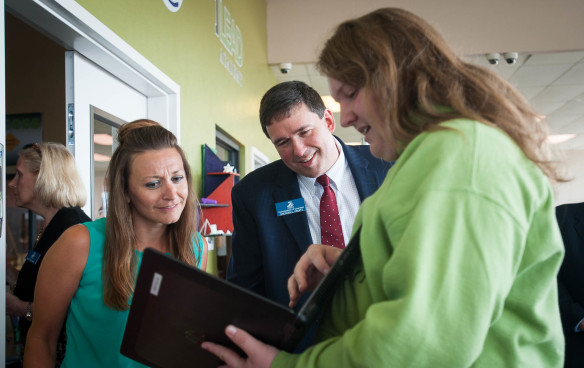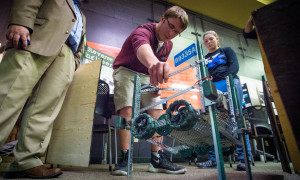
Education Commissioner Stephen Pruitt talks to 9th-grader Blake Jaggers about his Civil War webpage during Pruitt’s visit to the iLead Academy in Carrollton.
Photo By Bobby Ellis, April 25, 2016
By Brenna R. Kelly
Brenna.kelly@education.ky.gov
Most high school students spend a lot of time in sitting a classroom, but at iLEAD Academy, the school’s one classroom gets little use.
“Nobody really ever wants to be in the classroom,” said Larisa McKinney, iLEAD director. Students at the newly opened career academy would rather be working in the school’s makerspace or sitting on bean bag chairs in the large collaboration area with their computers on their laps.

iLEAD freshman Jason Gray of Owen County demonstrates a robot that he built at the school’s demonstration night.
Photo by Bobby Ellis, March 24, 2016
And the 38 students often aren’t at the school at all.
“I think we’ve taken 35 field trips this year,” McKinney said, “and I’m not joking when I say we’ve probably taken 10 in the last three weeks.”
iLEAD Academy, which opened last fall, is the state’s first regional career academy. Students from five school districts in the Ohio Valley Education Cooperative (OVEC) are eligible to attend the school, which is designed to prepare students for the highest-demand, highest-wage jobs in the golden triangle region bordered by Louisville, Lexington and Northern Kentucky.
The school is run by OVEC and uses a project-based curriculum focused on science, technology, engineering and math. Students can choose from career pathways in engineering, biomedical and informatics – area that were chosen by OVEC based on a regional jobs forecast.
“Job creation and retention is 100 percent contingent upon the availability of a highly skilled workforce pipeline,” said Alicia Sells, OVEC’s director of innovation. “iLEAD is about developing that pipeline and preparing students to be highly competitive in the regional and global economy.”
The goal is for all students to be college- and career-ready by their junior year and then take classes at Jefferson Community and Technical College (JCTC) and graduate from high school with an associate degree.
The academy opened in the fall of 2016 and will double in size next school year when a new freshman class made up of students from Carroll, Henry, Owen, Trimble and Gallatin counties arrives.
“There are no bells, it’s a very flexible learning environment,” said McKinney, who came to the school after teaching science at Henry County Middle School.
“But the students have to learn to manage their time and they have to learn to self-advocate.”
Students take their general education classes such as English, mathematics and world civilization online, which allows them to work at their own pace, McKinney said.
Initially, some students struggled with the freedom. Students were used to the teacher telling them what to learn and how to learn it, said Jenna Gray, iLEAD instructor. Some students who were used to getting straight As suddenly were falling behind, she said.
“But once they get it, they are like ‘This is awesome,’” she said. “The kids want to be in control once you give them the tools and the power to do so.”
Through the Project Lead the Way (PLTW) engineering curriculum, students are learning design thinking and problem solving, Gray said.
They then use those skills to work on projects designed to help the community. As PLTW project, the students are helping General Butler State Park redesign its miniature golf course. Students also work on projects that combine engineering and their core academic classes. One group is building a table from reclaimed wood using shapes from geometry. The students are also testing the 19th-century wood to see the differences in today’s wood.
A another group is working on a project of vital importance to the students – food. The students are designing a bridge over a marshy area that separates their school – housed in a renovated strip mall – from a sandwich shop.
“They are tying it into what they’ve learned in world civilization about the Roman Empire and their architecture and giving it that type of design,” Gray said.
The strip mall location, which is next to a Kroger has also given the school a chance to showcase their projects, McKinney said.
“It’s almost like free advertising for us, because anything we do, we go out in the parking lot,” she said. In the fall, student-built catapults launched old fruits and vegetables donated by Kroger.
The centralized location also give the students quick accesses to the Carroll County Area Technology Center – where some students take classes in automotive engineering, welding, carpentry and electrical engineering – and JCTC.
Students are constantly coming and going from the school, with many also returning to the home school where they are still technically enrolled for breakfast, sports, clubs or band.
“They are still as much a part of their home school districts as they want to be,” McKinney said. “I try to be a flexible as possible in what they want to participate in.”
Just as students are embracing a new way to learn at the career academy, the teachers are also finding freedom in a new way of teaching.
“There’s no way now that I could ever go back to a regular classroom just because of the flexibility that we offer each kid,” McKinney said, “the way that we can personally work with each kid.”
Teaching at iLEAD is vastly different from her first 20 years in education, said Gray, who came to iLEAD after teaching mathematic and instructional technology at Owen County Middle School.
“People constantly say that teachers are supposed to be the facilitators of learning,” she said, “but then they bind us in these little boxes. But at iLEAD, we truly get to be mentors and facilitators.”
As the students and teachers adapt, the first year been both challenging and rewarding, McKinney said.
“It’s been a good year to process and to figure out what has worked and what has not worked,” McKinney said. “And I listen to the students’ feedback.”
For example, the school had to change the online learning management systems it uses for general education classes because the students were not engaged. The school found a much more interactive system with the level of rigor the academy wants to maintain, she said.
Because the school works on a mastery-based grading system, students must make an 80 percent or above before they can move on to a new lesson. That means students have to perform at a much higher level than they were used to, she said.
One student joked to McKinney that she should create a school bumper sticker reading: “I used to be on the honor roll before I came to iLEAD.”
McKinney believes the small classes and personal relationships make it possible to hold her students to high expectations “without making them want to go back home.”
It appears to be working. Recently iLEAD students had to make a choice, she said.
“I wanted them to let me know if they planned on returning,” McKinney said. “If not, I had to schedule them back into their home high school.”
She wasn’t sure what the students would say.
“But every single one of my kids are coming back,” McKinney said.
MORE INFO …
Larisa McKinney Larisa.McKinney@Ovec.org
Jenna Gray Jenna.Gray@Ovec.org








The iLEAD system sounds promising, just what is needed instead of one-size-fits-all. It is creative and practical.